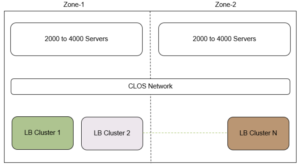In a world where more than 81% of Americans and 33% of the world’s population now shop online¹, retailers are challenged to grow their eCommerce storage platforms economically along with their businesses. While many retailers turn to public cloud services, many have chosen to host their own eCommerce storage infrastructure to optimize costs as they scale their customer base, while maintaining control of their customer data.
This blog will talk about how efficient, scalable eCommerce storage in a private cloud implementation can provide a solid foundation for online sales success.
Overview
- What is Cloud-based eCommerce?
- Essential Elements of Cloud-based eCommerce
- Architectural Considerations for an On-Premises eCommerce Platform
- A Cloud eCommerce Solution
- Conclusion
Why Build a Private Cloud for eCommerce?
A cloud-based eCommerce platform can be a virtual infrastructure hosted on public platforms that offer Infrastructure as a Service (IaaS) or a specialized Platform as a Service (PaaS) and that utilizes cloud computing technology to host and manage online stores.
Many online retailers have constructed their e-commerce platforms on AWS or Microsoft Azure owing to the scalability and efficiencies provided by these platforms.
However, on-premises eCommerce storage for private clouds is an alternative to the public cloud that can be a strategic decision for certain organizations for a variety of reasons:
- Data Control and Security: This is particularly relevant in the European Union, Canada, India, and many other countries, where strict regulations govern how customer data is handled and stored.
- Application Performance and Latency Requirements: eCommerce storage plays a critical role here where even slight delays in loading times can impact user experience and conversion rates.
- Reliability and Cost: Improper provisioning or allocation of resources can impact site reliability and burst IT budgets.
Ultimately, the decision to choose an on-premises data center over the public cloud for an eCommerce platform depends on the specific needs, priorities, and constraints of the organization in question.
In both models, the transition to a cloud-based eCommerce platform empowers businesses to swiftly adapt to fluctuating market requirements, promoting creativity and optimized processes.
Essential Elements of eCommerce Storage for Private Clouds
The essential elements of on-premises eCommerce storage encompass high-performance servers, software-defined storage for flexibility, and a robust networking infrastructure to ensure fast and secure communication. The integration of these elements contributes to the platform’s reliability, scalability, and overall efficiency in supporting eCommerce operations.
Software-defined Block Storage
Software-defined, high-performance block storage serves as the backbone for cloud commerce, offering a dynamic and agile foundation for businesses to establish and expand their digital presence. Software-defined storage (SDS) abstracts storage functions from the underlying hardware, providing flexibility and agility in managing storage resources. This abstraction allows for easier scalability and adaptability to changing storage requirements. It facilitates the pooling of storage capacity across multiple devices and ensures that resources are used optimally, minimizing the risk of storage bottlenecks and enhancing overall system performance.
SDS enables cost-efficient scaling by optimizing the use of existing hardware resources. It allows businesses to expand storage capacity without necessarily investing in additional physical storage servers, contributing to a more efficient use of resources. E-commerce businesses can achieve cost savings by optimizing resource usage without compromising on reliability or performance.
In an eCommerce environment where agility is key, SDS facilitates rapid provisioning of storage resources. This quick response time allows for dynamic adjustments in storage configurations to adapt to changing workloads, ensuring optimal performance during peak periods without over-provisioning resources during quieter times.
NVMe over TCP Storage Protocol
The NVMe® over TCP (NVMe/TCP) storage protocol is increasingly being recognized as an ideal solution for cloud-based eCommerce platforms due to its combination of high performance, scalability, and cost-effectiveness. Where swift response times are crucial for providing an optimal user experience, the reduced latency of NVMe/TCP can significantly enhance the performance of storage operations, leading to faster page loads and seamless transactions. It operates over standard TCP/IP networks, making it compatible with existing network infrastructures commonly used in cloud environments. This ensures easy integration into cloud-based eCommerce platforms without the need for significant network overhauls or specialized hardware.
Architectural Considerations for an On-Premises eCommerce Platform
Now that we understand the essential elements of a cloud-based eCommerce platform, here are some architectural considerations to ensure reliability, efficiency, and scalability.
Flexibility and Scalability
Adopting a microservices architecture enables the eCommerce platform to be modular and scalable. Each microservice can handle specific functions (e.g., product catalog, checkout, payment processing), allowing for independent scaling based on demand. This approach enhances flexibility and facilitates cost-effective resource allocation. Orchestration tools such as Kubernetes (K8s) provide a scalable and efficient way to manage microservices. Containers can be easily replicated and scaled horizontally, optimizing resource utilization and reducing operational costs. But storage has the potential to be a drag on K8s potential value. Local Flash or DAS invariably leads to poor storage resource utilization and high costs and threatens to impede K8s portability, which is one of the technology’s most compelling benefits. SDS offers the levels of performance required by popular apps running on K8s while preserving K8s portability and agility.
Distributed and Composable Architecture
A distributed and composable architecture offers a powerful framework for building scalable, resilient, and adaptable systems. Distributed architectures excel at horizontal scaling and are essential for systems experiencing growth, ensuring that they can accommodate higher levels of traffic, data, or transactions. While the composable architectures enable the allocation and reallocation of resources based on specific needs. This flexibility optimizes resource utilization, preventing over-provisioning and reducing unnecessary costs. By leveraging the advantages of disaggregation and composability, platform engineers can meet the demands of their eCommerce applications and services while optimizing costs and maintaining a competitive edge.
Lightbits Cloud Data Platform for eCommerce
Lightbits offers an ideal solution for cloud-based eCommerce, offering reliability, high performance, and cost-efficiency. Lightbits ensures optimal resource utilization by disaggregating servers and storage, preventing overprovisioning during peak sales times. This efficient and agile storage platform scales seamlessly with business growth, preventing costs from skyrocketing.
As a software-defined solution leveraging NVMe/TCP, Lightbits provides economic advantages by utilizing commodity servers and storage, replacing direct attached storage (DAS) to enhance availability and resource utilization. The clustered architecture ensures high availability, eliminating service disruptions in case of node or drive loss, and multi-zone synchronous replication provides reliability. Enterprise-grade data services, such as snapshots and clones enhance data management, while multi-tenancy and Quality of Service (QoS) features guarantee a seamless user experience.
Lightbits Powers One of the World’s Largest eCommerce Platforms
For this customer’s eCommerce platform, Lightbits delivers a flexible, agile, and efficient persistent storage solution that makes it possible to enjoy the advantage of K8s portability without compromising on storage performance or scalability. The NVMe/TCP software-defined storage solution can support hundreds of K8s clusters from a single Lightbits storage cluster without inhibiting K8s container portability model. By moving to a disaggregated persistent storage solution based on Lightbits, they enable mobility for their K8s workloads across the entire cluster.

eCommerce organization’s data center design
This IT organization also liked the rich data services supported by Lightbits. By utilizing thin-provisioning and compression, the organization was able to improve its utilization and efficiency enormously compared to its legacy DAS architecture. The Lightbits platform also allows for automated deployment of Lightbits storage servers and, by using snapshots and clones, easily create new compute environments or a clone of their production data for testing and development purposes.
Conclusion
In the evolving landscape of technology for online retail, there are many nuances to consider when architecting a platform for reliability and efficiency. In exploring the intricacies of on-premises cloud-based eCommerce platforms, I highlighted the vital role of software-defined storage (SDS) and the transformative NVMe/TCP storage protocol. A strategic approach to the system design can make a dramatic impact on dynamic provisioning for fluctuating user demands, optimizing resource utilization, and curbing unnecessary infrastructure costs.
The success story of one of the world’s largest eCommerce platforms underscored Lightbits’ efficacy in delivering high performance, scalability, and efficiency—an essential balance in the dynamic eCommerce environment. Crucially, Lightbits allows businesses to retain flexibility in architecture over their on-premises platforms, ensuring enhanced efficiency, cost-effectiveness, and an elevated eCommerce experience for both businesses and end-users. As the eCommerce sector continues its relentless growth, Lightbits emerges as a pivotal enabler, providing a pathway to adaptability, innovation, and superior performance in this dynamic digital marketplace.
Related resources:

